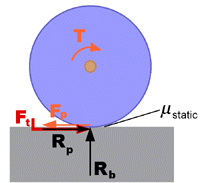Traction
Traction is simply the force of friction between the drive wheel tread and the racetrack.
The friction between two items that are pressing together is very easy to calculate. Friction force (F) is determined by the force with which the items are pressing together (called the normal force), and the coefficient of static friction between the two surfaces.

In the figure above, suppose that Rb is the normal force, and mu-static is the coefficient of static friction. We would like to calculate Ft, the friction force, which is Traction. The equation is:
Ft = Rb * mu-static
Suppose that the normal force Rb is 0.75 lb (this means that 0.75 lb of weight is being carried by the wheel). Also suppose that the coefficient of static friction is 0.90. Then the Traction (Ft) is:
Ft = (0.75 lb) * (0.90) = 0.675 lb
It is important to be able to compute the traction, because if the propulsive force exerted by the wheel is greater than the wheel's traction, the wheel will skid, and the car may "spin out".
Question: In the figure above, Fp is the propulsive force, equal to 0.50 lb. Ft is the wheel's traction, equal to 0.675 lb. Will the wheel skid?
Answer: It will not skid, because the wheel has enough traction capacity (0.675 lb) to absorb the propulsive force, which is only 0.50 lb. But if the propulsive force were greater than 0.675 lb, it would overcome the traction resistance and begin to skid.
Help Index